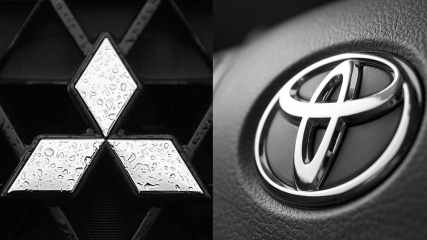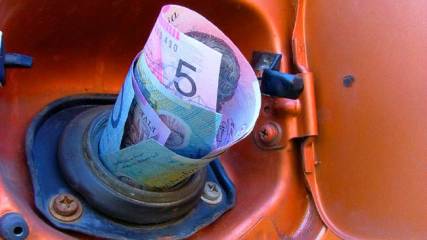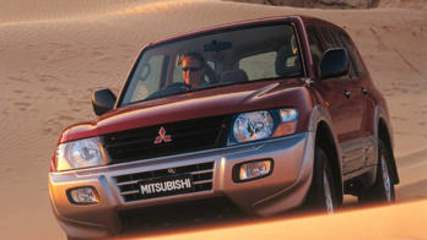Mitsubishi Pajero 2008 News

800,000 cars recalled in two days
Read the article
By Joshua Dowling · 30 Jun 2016
Cars are either being built worse -- or companies are getting better at detecting faults.a range of models made over the last 10 years replacing potentially deadly Takata airbags in 1.3 million cars in Australia. a second, airbag-related recall for the Priusreplacing potentially deadly Takata airbags in 1.3 million cars in Australia

Beat the bowser
Read the article
By Mark Hinchliffe · 19 May 2011
And each week it seems the fuel price sign goes up faster than a politician's pay packet. Australians use a vast amount of fuel in going about their daily business, be it getting the kids to school, travelling to and from work, or conducting the nation's business.Each year we import an ocean of petrol, diesel and LPG that's equivalent to 63,000 Olympic swimming pools. And we're not alone, as the vast populations of newly mobile countries such as India and China take to the roads in their Tatas, Great Walls and Cherys, the world's thirst for oil seems ever more insatiable.Overlay this with war and unrest in the Middle East, the source of 56 per cent of the world's oil, and the inevitable push-pull dynamics of supply and demand can lean to only one thing: higher fuel prices.Here in Australia motorists have been feeling the pinch of higher fuel prices since January when the latest spike in oil prices first began appearing on service station leader boards.The spiralling petrol prices mean fuelling a family car like a Commodore or Falcon now accounts for 2.6 per cent of average weekly earnings. But you don't have to sit back and take it in the hip pocket. There are ways to drive down your weekly fuel bills. Here are a few of them.DOWNSIZING According to VFACTS industry statistics, this seems the most popular choice. Large cars have gone from the top-selling passenger segment in 2000 with 198,766 to the smallest passenger segment last year with 98,583 and falling at 3.1 per cent.Meanwhile, sales of smaller cars are skyrocketing. In the past 10 years small car sales have almost doubled to 239,191 while light cars have increased about 44 per cent to 137,916. You can buy a small car from as little as $11,990 (plus on-road costs) for the Chinese-made Chery, right up $35,990 for a Citroen DS3.And you won't go without. Some of the cheapest little cars these days come with a swag of safety and creature features from multiple airbags to Bluetooth connectivity.PROS: Save on fuel; do the environment a favour; easier to park; nippier in traffic; little hatches can be cavernous if you fold down the rear seats.CONS: You get cramped on long journeys; they are noisier on the highway; they're bumpier over potholes; you could feel a little silly driving a Smurf car.Our Pick: Hyundai i20 (from $15,490) is set to take over from Getz as the segment leader with Euro styling and a high level of features and safety.Others to Consider: Suzuki Swift (from $15,990), Mazda2 (from $15,790) and Toyota Yaris (from $14,990).DIESEL Like smaller car categories, the growth in diesel-powered vehicles is exponential. Since the Federal Chamber of Automotive Industries began collating separate figures for various fuel types in 2005, diesel cars and SUVs have more than doubled to 125,555 last year, which is almost one in every five new passenger cars or SUVs bought today.The reason is that modern diesel engines are not only up to twice as frugal as a petrol vehicle, but they often have lower emissions because they burn less fuel per kilometre and usually have an exhaust system that traps small carbon materials.Modern diesels are also quieter and smoother running. However, diesel engines have higher internal pressures and a complex fuel system so they are more expensive to build than a petrol engine. Some car companies charge up to $10,000 more for a diesel variant, although most charge around an extra $2000.Expensive diesels are often the result of low production volumes and highly technological designs and machining costs. To reap the economic benefits you have to drive big kilometres each year and hold on to the vehicle longer.An extreme example is the Holden CD Cruze auto diesel that costs $4000 more than the petrol model. Based on RACQ's fuel running costs of 9.36c/km for the petrol and 8.41c/km for the diesel, you would have to drive 25,000km for 16 years to recoup the extra cost.PROS: Fuel economy is anywhere between 10-50 per cent better than a petrol equivalent; more torque means quicker acceleration and easier driving around town; better towing capacity; marginally better resale value; lower CO2 emissions per kilometre; diesel engines often last longer because of the more robust engineering.CONS: Fewer diesel pumps on servo forecourts means queuing at the servo; oily bowser pumps leave your hands smelly and dirty; the engines still clatter at idle and sound raucous at full revs; it takes a long time to reap the economic benefits; servicing charges can also be more expensive because of the more expensive oils required and the complicated fuel systems.Our Pick: Fiesta ECOnetic (from $24,990) is a hybrid beater even in stop-start commuting, yet it's a delight to drive.Others to Consider: Hyundai i30 (from $23,090), VW Golf (from $29,990), Subaru Forester (from $35,990).LPG It's almost worth it to convert your petrol or diesel vehicle to LPG just to get the $1500 Federal government subsidy. But you better be quick because the conversion rebate drops to $1250 from July 1 and decreases $250 annually. All rebates and subsidies are only for private vehicles.Conversions cost an average of $2800 for pre-2006 vehicles, but about $4000 for newer vehicles because of emissions regulations. If you buy a vehicle factory fitted for LPG before its first registration, you get a $2000 rebate from the Feds.However, choices of new vehicles with factory fitted LPG systems are limited. Ford has a new LPG Falcon coming in July and has factory-fitted systems for some of its utes. Holden has an Autogas dual-fuel injection system for its Commodore and will have a mono-fuel LPG Commodore later this year.Toyota has a direct injection LPG system for its 2.7-litre HiAce vans and Mitsubishi has an aftermarket sequential multi-port direct-injection system for its Challenger, Express Van, Pajero, Triton and the now defunct 380.PROS: Much cheaper fuel (about 60c compared with $140+ for ULP); government subsidies make conversion attractive; LPG prices are fairly static so you don't have to fill up on a Tuesday morning when servo prices are cheapest; lower emissions.CONS: Limited choice of new dual-fuel vehicles; only suitable for large vehicles; you lose boot space; even though they are safe they can develop minor smelly leaks; they add about 75kg (about the weight of two large suitcases) to the rear of the car effecting handling; it can be difficult finding servos with LPG in rural areas.HYBRID These are vehicles with petrol or diesel internal combustion engines paired with an electric motor or motors. The drivetrain and associated battery pack for the electric motor is more complex so therefore more costly. Like diesels, you need to do big kays before the savings at the bowser recoup the extra purchase price.For example, a Toyota Prius costs about $2500 more than a Corolla Ultima. Using RACQ's running costs, the fuel savings will take 4 years at 15,000km a year (or 2.5 years at 25,000km/year) to recoup the extra purchase price.Most hybrids switch off totally every time you stop and run on electric power only when you are driving slowly, so they are most economical in heavy traffic. The benefits are marginal on country roads and highways, although when both drive units are operating under heavy acceleration such as when overtaking, they do offer a tangible boost to acceleration.Despite the fact the technology has been around for 10 years, Hybrids are still relatively new. Today, there are 10 hybrid models on the market, but only the Toyota Prius, Camry, Honda Insight and Civic are affordable.Hybrids tend to be bought mainly by governments and big business to emphasise their green credentials. Taxi companies also like hybrids because of their fuel efficiency in urban environments. If you're open to the idea of a used vehicle, then a second-hand Prius or similar is a reasonable option.PROS: Cheaper to run in traffic; feel and be seen to be environmentally conscious; extra power under heavy acceleration; almost silent running when on electric only power.CONS: Higher purchase price; the number of models is limited but you can choose from a small Prius to a large Porsche Cayenne SUV; some look odd like the Prius and Insight.Our Pick: Toyota Prius (from $39,900) and the Honda Insight (from $29,990) at least look like futuristic hybrids, so your neighbours will know you are trying to be green.Others to consider: Honda Civic (from $34,490), Toyota Camry (from $36,990)ELECTRIC CARSThe only production electric cars in Australia are the Tesla Roadster at $241,938 and the Mitsubishi i-MiEV which is available only on a lease of $1740 a month for three years for a total of $62,640. Then the car goes back to Mitsubishi. When it arrives it is expected to cost $70,000.However, prices will come crashing down in the next few years as more and more EVs become available in Australia. The first of these will be the Nissan Leaf and Holden Volt next year.The Volt is expected to cost less than $40,000 and Nissan is saying the Leaf will cost about the same to run as a Tiida, even though initial outlay will probably be close to the Volt. While tailpipe emissions are zero, most electricity in Australia comes from burning dirty coal, so the environmental advantage is reduced.Some critics say there is no advantage. Current limitations of battery technology mean range is also limited to about 160km according to the car companies, but in real life it's less, especially if you have a lead foot.PROS: Very cheap to run; no tailpipe emissions; almost silent running; aerodynamic body shapes.CONS: Expensive to buy - that's if you can find one to buy; silent running can be dangerous for pedestrians; battery disposal is an environmental issue; range is limited; long re-charging time (up to eight hours); most EVs are designed to look futuristic but just end up looking like golf carts.DRIVE ECONOMICALLYOf all the things you can do to drive down your fuel bill, this is the most pragmatic as it's the simplest and most affordable. It can be expensive to swap your trusted and much-loved family car or SUV for something smaller or with an alternative powertrain.Trade-in prices on family cars are down according to the Motor Trades Association and if you buy a new car, you are up for dealer delivery charges, stamp duty and registration. It may be cheaper to hang on to your vehicle, but modify your driving behaviour for more economical running.There are many simple things you can do: Plan trips better and make fewer trips; jettison excess weight from the car; correctly inflate your tyres and get your car serviced more frequently.Most importantly you can vary your driving behaviour by slowing down, changing up the gears sooner, avoiding heavy breaking and staying away from peak-hour traffic. You may have heard these all before, but here are five radical ideas to reducing your fuel expense burden that you may not have heard.1. Cool idea: Turning off the airconditioning will provide a slight increase in fuel economy. However, when travelling on the highway, it is more fuel efficient to have the windows up and aircon switched on than having the windows down creating aerodynamic drag. Don't leave the aircon off for long periods as bacteria will build up in the system.2. Light is right: So throw out not only the unnecessary baggage such as your golf clubs, but maybe also the spare tyre. It can weigh 15-20kg in the average car. The US Department of Energy quotes fuel use as 1-2 per cent for every 45.5kg, so that's at least 0.5 per cent saved. Conversely, NRMA tests show that loading a vehicle to its rated maximum increases fuel consumption 24 per cent. While you might be able to get away without a spare tyre around town, we recommend you always carry it on long trips, especially in the country.3. Turned off: Switch off the engine at long traffic light stops. Modern fuel-injected cars start quickly without the need for any throttle. Car makers with stop-start technology that automatically switches off the engine every time the car is stopped quote fuel savings in traffic of 4-5 per cent.4. Just cruising: Use cruise control more frequently. Most cruise control systems actually put the car's engine into an economy mode and will run more efficiently than most drivers can drive as it accelerates more evenly. It is best used on the open road and not hilly terrain or stop-start conditions. While we could not find any official figures, some sources claim fuel savings up to 14 per cent.5. Re-tyre: the next time you buy tyres, choose from the new range of "eco" tyres with low rolling resistance. A California Energy Commission study estimated low-rolling resistance tyres could save 1.5-4.5 per cent on fuel consumption.

Recall flurry
Read the article
By CarsGuide team · 10 Nov 2008
In extreme situations, owners have been warned their vehicles may catch fire.Mitsubishi was hit with the biggest safety recall for the three month period. It has written to owners of Pajeros built between 2000 and 2003 to warn them of a potential brake problem. As many as 13,400 vehicles may need to be checked.The company also recalled 4400 of its now-defunct 380 sedan, built between 2006 and 2007, which may have a faulty fuel tank retaining strap. In a severe collision the tank may be dislodged and spill fuel.Mitsubishi is also checking more than 8300 Colts built this year which may have a problem with door windows which may drop and unlock or open the door while the car is being driven.Honda has recalled 11,800 of its 2004-05 Jazz to check whether they have a faulty handbrake, while Mazda needs to look at 1770 of its B4000 utes built between 2005-2006 because the bonnet may open unexpectedly.Subaru has recalled 5380 of its Imprezas, built between 2001 and 2003 because of a faulty rear tailgate which may suddenly drop.Subaru Australia spokesman, Dave Rowley, said many of the recalls were to check for "minor or niggling" faults."We have had no incidents of anyone being injured in Australia and we found only six cars which had the faulty (tailgate strut) connection."Many recalls are done as a pre-emptive measure to avoid possible problems further down the track, " he said.Other potential faults include electrical short circuits, which in extreme circumstances, may start a cabin fire in Landrover Freelander diesels built since 2007. Landrover warns the fault may occur when the vehicle is parked and unattended.Other recalls were to check for short circuits in Fiat's Grande Punto; and a chance that the panoramic glass roof in a small number of Citroen's Picasso could be dislodged.Suzuki has warned of potential fire risk in its 3-door Suzuki Grand Vitara (2006-07) because of a possible cracked fuel pipe, while the 2005-08 Vitara diesel has a remote fire risk in a filter because of a problem with the intercooler outlet pipe insulator.Other problems include faulty rear seat belt D-loop attachments in the current Jaguar XF, and the potential for a loss of steering in Chrysler's 300C built last year because of a problem with rear axle hub nuts which could see the half shaft disengage from the wheel hub.Mercedes Benz wants to look at axles, springs and the park brake in its Sprinter or Vito vans.Jayco has recalled some of its motor homes to check and fix awning and exhaust pipe problems.Of the 1500 motorcycles recalled, safety issues to be fixed include a faulty fuel filler on Kawasaki models, a windshield which may come off Buell bikes if ridden at high speed and a rear view mirror which may fall off on certain Yamaha models.An ACCC spokeswoman said this year's figures were actually less than last year but the number has been steadily rising over the past 20 years.The ACCC says there have been 52 individual recalls this year compared to 171 last year.Full details of the recalls can be found at www.recalls.gov.au

WAECO 4x4 Action Track
Read the article
By CarsGuide team · 04 Oct 2008
A purpose-built 4x4 track at the Australian International Motor Show offers visitors the chance to evaluate a range of different vehicles.Show-goers are able to experience as close to a real-life off-roading situation as you can get in the city.Exhibiting 4WD brands are:Hyundai - Santa FeJeep - WranglerKia - Sportage, SorentoLexus - LX 570Mitsubishi - Triton GLX-R, PajeroNissan - X-TRAIL Turbo DieselRenault - KoleosToyota - Landcruiser 200Volkswagen - TouaregVisitors to the show interested in a particular 4x4 will receive a VIP pass to the 4x4 track to experience the vehicle’s performance and are driven around the track by a professional driver.Track is built to demonstrate the abilities of each vehicle and obstacles are designed to demonstrate the vehicles’ increasingly advanced technology and abilities.The see-saw gives an indication of vehicle balance, the hill structure tests traction and control, the moguls and rocks show-off ground clearance and the new addition of the u-turn at the end of the track demonstrates the tightness of the turning circleThe vehicles navigate the track in slow motion; just as experienced four-wheel-drivers would approach such obstacles in real-life situations.





